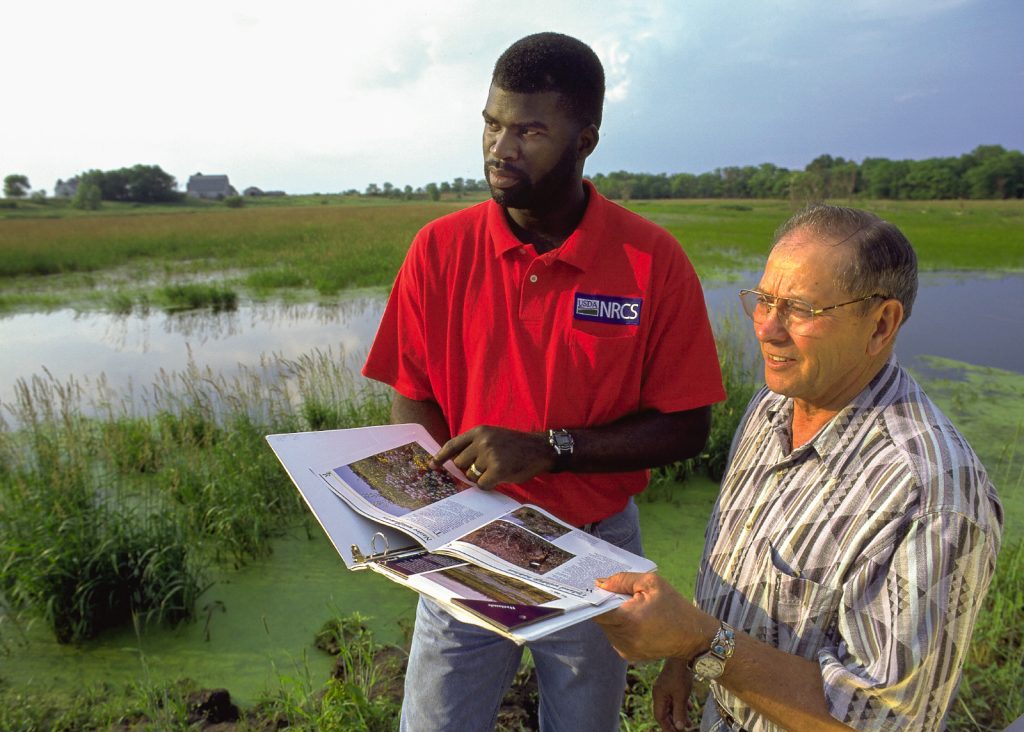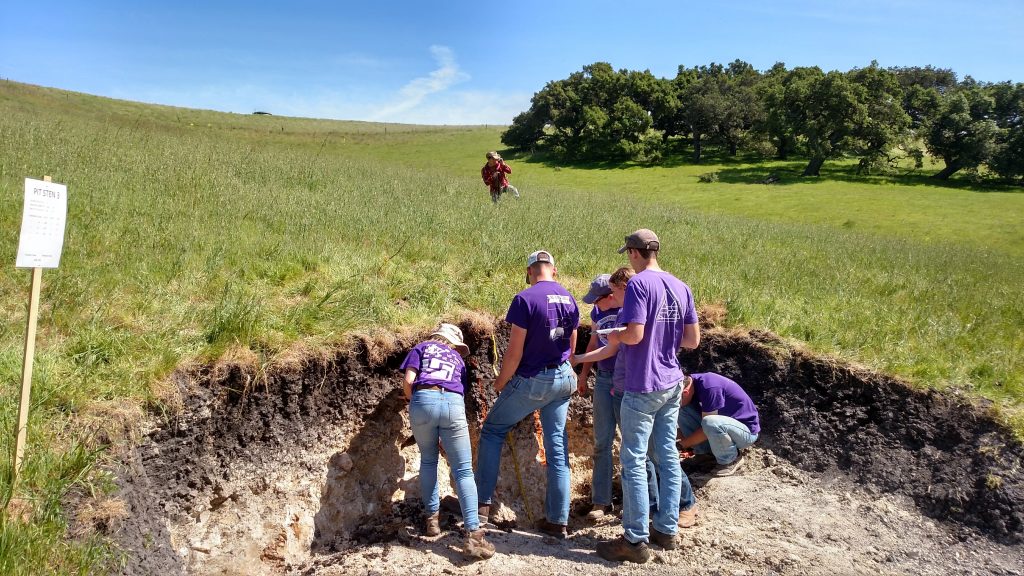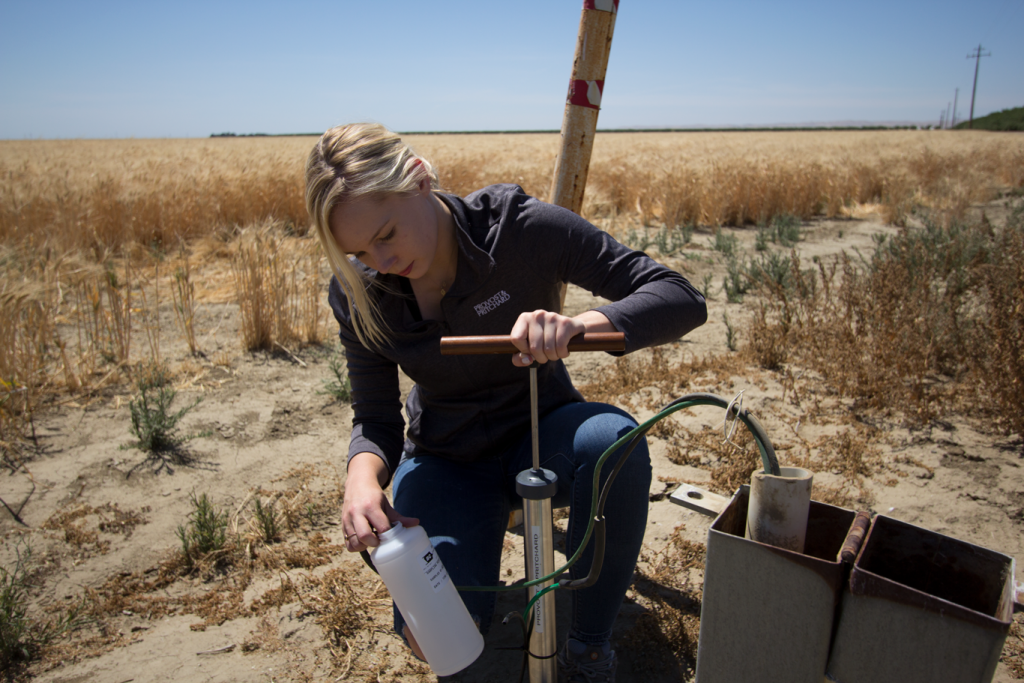13 Careers in Soil and Water Conservation
Colby Moorberg and Eric Brevik
Abbreviations
AGI – American Geosciences Institute
AGU – American Geophysical Union
AIH – American Institute of Hydrology
ASA – American Society of Agronomy
ASABE – American Society of Agricultural and Biological Engineers
CESSWI – Certified Erosion, Sediment and Stormwater Inspector
CF – Certified Forester
CMS – Clay Minerals Society
CPAg – Certified Professional Agronomist
CPESC – Certified Professional in Erosion and Sediment ControlCPISM – Certified Professional in Stormwater Management
CPMSM – Certified Professional in Municipal Stormwater Management
CPRM – Certified Professional in Rangeland Management
CPSC – Certified Professional Soil Classifier
CPSS – Certified Professional Soil Scientist
CPSWQ – Certified Professional in Stormwater Quality
CSSA – Crop Science Society of AmericaEPA – US Environmental Protection Agency
ESA – Ecological Society of America
GS – General Schedule
GSA – Geological Society of America
NACD – National Association of Conservation Districts
NACTA – North American Colleges and Teachers of Agriculture.
NRCS – Natural Resources Conservation Society
NSPE – National Society of Professional Engineers
PDF – Portable Document Format
PE – Professional Engineer
PG – Professional Geologist
PH – Professional Hydrologist
PWS – Professional Wetland Scientist
SAF – Society of American Foresters
SASES – Students in Agronomy, Soils, and Environmental Science
SRM – Society for Range Management
SSSA – Soil Science Society of America
SWCS – Soil and Water Conservation Society
SWS – Society of Wetland Scientists
URL – Uniform Resource Locator
US – United States
USACE – US Army Corps of Engineers
USDA – US Department of Agriculture
Education and Careers in Soil and Water Conservation

AgCareers.com. 2019. Career Profiles. https://www.agcareers.com/career-profiles/.
The AgCareers website provides information on a number of different careers in agriculture, including jobs that can be pursued by soil scientists. Information includes the type of educational background required to pursue the given career (both high school preparation and college training), kinds of jobs, and job market outlook.
ASA CSSA SSSA. 2019. Colleges and Universities. https://www.careerplacement.org/colleges.
This page from the ASA, CSSA, and SSSA provides a partial list of universities that provide training in agronomy, crop science, soil science, and environmental science. It is a particularly good resource for high school students looking for degree programs in one of these areas.
ASA CSSA SSSA. 2019. Science Societies Career Center. https://www.careerplacement.org/.
This Career Center website is a job listing website focused on job seekers and recruiters in agronomy, crop science, and soil science disciplines. It allows job seekers to post resumes, which can then be reviewed by recruiters and potential employers. It also lists active job openings that can be reviewed by applicants.
EnvironmentalScience.org. 2019. Careers in Environmental Science. https://www.environmentalscience.org/careers.
The Careers in Environmental Science website gives information on what environmental scientists do, where they can find employment, expected salary levels from different employers, the future job outlook, and where to get relevant education. While soil science is not specifically mentioned as an environmental science preparatory degree, the website gives several examples of places where soil science knowledge is important to the environmental field.
SSSA. 2019. A Day in the Life. https://www.soils.org/careers/a-day-in-the-life.
This SSSA web page features career profiles of professionals in the soil science discipline. It includes career profiles of 25 soil scientists. Each profile begins with a summary of each soil scientist’s career, followed by a question-and-answer interview between the SSSA and the profiled soil scientist.
SWCS. 2019. Student and Early Career Resources. https://www.swcs.org/resources/conservation-career-profiles/.
This web page from the SWCS provides students and early career professionals two resources to help plan a career in conservation. First, it contains a link at the top of the page for a 23 page SWCS Guide for Students and Early Career Professionals in Conservation as a PDF. In addition, it contains career profiles of conservationists in various types of careers in the discipline.
SWCS. 2019. SWCS Conservation Career Center. https://swcs.careerwebsite.com?site_id=22892.
This Conservation Career Center website from the SWCS provides a platform for job seekers and recruiters for the soil and water conservation profession. Using an account as either a job seeker or a recruiter, people can review or post positions for openings in soil and water conservation. There is also a feature for a free resume review to improve the quality of user resumes.
US Office of Personnel Management. 2019. General Natural Resources Management and Biological Sciences. https://www.usajobs.gov/Search/ExploreOpportunities/?Series=0401.
USAJOBS.gov lists open positions in federal agencies like the USDA NRCS, EPA, USACE, and more. Users create a profile with different resume documents and then may apply for a range of jobs. This web page within USAJobs.gov lists all jobs related to natural resources management and biological sciences related to plant and animal life.
USDA NRCS. 2019. Plan Your Career. https://www.nrcs.usda.gov/wps/portal/nrcs/main/national/careers/plan/.
Important information on careers with the USDA NRCS is provided. Specific information is provided for positions as a Soil Conservationist and Soil Scientist, including job functions for each position, qualifications for each level, and typical career paths. The GS grades for each position are also given, which allows prospective employees to look up information on pay rates.
Professional Societies
AAG. 2019. American Association of Geographers. http://www.aag.org/.
The AAG brings together professionals in all aspects of geography, spanning the cultural and physical sides of the field. This includes geographers who work on soil issues. AAG provides networking opportunities, meetings, publications, and works to form bridges with related fields.
AGI. 2019. American Geosciences Institute. https://www.americangeosciences.org/.
The AGI is a network of professional associations that represent geoscientists of all types. Member societies include several that have soil scientists in their membership, including the AAG, AGU, AIH, CMS, GSA, and SSSA.
AGU. 2019. American Geophysical Union. https://www.agu.org/.
The AGU represents scientists that study any aspect of the Earth and space sciences, ranging from astronomers to atmospheric scientists to soil scientists.
AIH. 2019. American Institute of Hydrology – The Society for Certification of Hydrology Professionals. https://www.aihydrology.org/.
The AIH offers professional certification to individuals with a background in any scientific or engineering field who seek to work as hydrologists. This certification ensures that unqualified individuals do not work on the many water projects that are important in our modern society.
ASA. 2019. American Society of Agronomy. https://www.agronomy.org/.
The ASA focuses on the production of crops and turfgrass, including all related areas. Because of the importance of soil in such production, many soil scientists are members of ASA, and the ASA has a special working relationship with the SSSA.
ASA. 2019. SASES: Students of Agronomy, Soils, and Environmental Sciences. https://www.agronomy.org/undergrads.
Undergraduate student members of the ASA, CSSA, and SSSA are members of SASES. Students are affiliated with agronomy, crops, soils, plant science, or environmental science clubs around North America.

ASABE. 2019. ASABE – American Society of Agricultural and Biological Engineers. https://www.asabe.org/.
The ASABE works to advance engineering in agricultural, biological, and food systems. Membership is open to both engineers and non-engineers who have an interest in the society’s mission. Benefits to members include national and sectional meetings, publications, and established standards.
CMS. 2019. Clay Minerals Society. http://www.clays.org/.
The CMS focuses on the study of clays and clay minerals. Given the importance of these fine materials in soil, many soil scientists are members of CMS and contribute to their meetings and publications.
CSSA. 2019. Crop Science Society of America. https://www.crops.org/.
The CSSA applies plant science to improve the world we live in. Because of the importance of soil to plant production, many soil scientists are members of CSSA, and CSSA has a special working relationship with the SSSA.
ESA. 2019. Ecological Society of America. https://www.esa.org/.
The ESA seeks to promote ecological science among scientists, increase public awareness of ecological science, increase the resources available to ecological scientists, and ensure the proper use of ecological science in decision making. Benefits to members include meetings, networking, and publications.
GSA. 2019. Geological Society of America. http://www.geosociety.org/.
The GSA represents more than 20,000 geoscientists in countries around the world. They are interested in all aspects of the geosciences and include a Soils and Soil Processes division. GSA serves their members with meetings, publications, and research grants and works to raise public awareness of the geosciences.
NACD. 2019. National Association of Conservation Districts. http://www.nacdnet.org/.
The NACD represents the 3,000 conservation districts in the US along with the people who serve on their governing boards. NACD encourages responsible use of natural resources through established relationships with governmental and non-governmental agencies and industry, educational programs, and publications.
NACTA. 2019. NACTA – North American Colleges and Teachers of Agriculture. https://nactateachers.org/.
The NACTA focuses on providing quality postsecondary education in agriculture and related areas by providing forums to discuss all aspects of such education, including a journal.
NSPE. 2019. National Society of Professional Engineers. https://www.nspe.org/.
The NSPE brings together PEs from all engineering disciplines to discuss issues important to engineers. This includes monitoring legislation that may affect engineers, providing continuing education required to retain PE status, and establishing a code of ethics that engineers must adhere to.
SAF. 2019. Society of American Foresters. https://www.eforester.org/.
The SAF encourages making forest management decisions based on sound science, balancing the needs of modern society with sustainability of forest resources. SAF also seeks to enhance the abilities of its members through meetings, networking, education, and certification.
SRM. 2019. Society for Range Management. http://rangelands.org/.
The SRM is dedicated to studying rangelands, so they can be conserved and managed sustainably through meetings, publications, and other resources made available to members.
SSSA. 2019. Soil Science Society of America. https://www.soils.org/.
The SSSA is the largest professional organization in the US devoted to professional soil scientists and is one of the largest such organizations in the world. SSSA offers services to soil scientists including networking, publication, professional development, and professional certifications.
SWCS. 2019. Soil and Water Conservation Society. https://www.swcs.org/.
The SWCS is dedicated to conserving our natural resources. SWCS has chapters in all 50 states as well as Canada, Mexico, and US Territories. It serves members with conferences, publications, engagement in policy discussions, research projects, and professional development.
SWS. 2019. Society of Wetland Scientists, an International Organization. http://www.sws.org/.
The SWS encourages understanding, conserving, protecting, restoring, and using science-based management of wetlands to promote sustainability through meetings, publications, public outreach, and professional certification.
Professional Credentials
AIH. 2019. Hydrology Certification. https://www.aihydrology.org/hydrology-certification.
This web page from the AIH includes information on the education and experience needed for the PH certification. It also explains examination requirements and fees and links to relevant documents and forms.
ASA. 2019. Certifications. https://www.agronomy.org/certifications.
Information is provided on several certifications offered by the ASA, including the CCA and the CPAg credentials.
EnviroCert International, Inc. 2019a. CESSWI – Certified Erosion, Sediment and Stormwater Inspector. https://www.envirocertintl.org/cesswi/.
Information on becoming a CESSI, including the career benefits of becoming a CESSI and proficiencies that a CESSI must demonstrate.
Envirocert International, Inc. 2019. CPESC – Certified Professional in Erosion & Sediment Control. https://www.envirocertintl.org/cpesc/.
Information is provided on becoming a CPESC, including the career benefits of becoming a CPESC and proficiencies that a CPESC must demonstrate.
EnviroCert International, Inc. 2019b. CPISM – Certified Professional in Stormwater Management. https://www.envirocertintl.org/cpism/.
This web page provides information on becoming a CPISM, including the career benefits of becoming a CPISM and proficiencies that a CPISM must demonstrate.
EnviroCert International, Inc. 2019c. CPMSM – Certified Professional in Municipal Stormwater Management. https://www.envirocertintl.org/cpmsm/.
This web page explains how to become a CPMSM and includes the career benefits of becoming a CPMSM and the proficiencies a CPMSM must demonstrate.
EnviroCert International, Inc. 2019d. CPSWQ – Certified Professional in Stormwater Quality. https://www.envirocertintl.org/cpswq/.
The procedure for becoming a CPSWQ is explained, career benefits of becoming a CPSWQ are included, and the proficiencies a CPSWQ must demonstrate are provided.
EnviroCert International, Inc. 2019e. Envirocert International, Inc. https://www.envirocertintl.org/.
General information is provided on the certifications provided by EnviroCert International, Inc., and how they can advance professional careers. Information is also given on the EnviroCert International, Inc.
NSPE. 2019. What is a PE? https://www.nspe.org/resources/licensure/what-pe.
This page explains what a PE is, the process of becoming a PE, and why being a PE is important. Information is also provided on PE licensure programs.
SAF. 2019. Professional Development. https://www.eforester.org/Main/Certification_Education/Certified_Forester/Main/Certification/Certification_Home.aspx.
Information is provided on becoming a CF, including required educational background, the CF application, reasons to hire a CF, and a directory to find a CF if you need one. Information is also included on CF continuing education requirements and on states that have forestry licensure.
SRM. 2019. Certified Professional in Rangeland Management (CPRM) Committee. http://rangelands.org/committees/cprm-committee/.
The process for becoming a CPRM is explained. Education, experience, and examination requirements are provided along with continuing education requirements to retain certification.
SSSA. 2019. Certifications. https://www.soils.org/certifications.
Information on certifications specific to soil science, including the CPSS and CPSC credentials. This includes education and testing requirements for certification, benefits of certification, and information on who should be certified. A searchable directory of certified soil scientists is also provided.
SWS. 2019. Society of Wetland Scientists Professional Certification. http://www.wetlandcert.org/.
This website provides an explanation of the PWS certification program offered by the Society of Wetland Scientists. Certification requires that applicants meet certain educational and experience requirements. Certification must be renewed every five years by completing appropriate continuing education.
SSSA. 2019. State Soil Science Licensing and Legislation. https://www.soils.org/certifications/already-certified/licensing.
This web page from the SSSA lists contact information for the governing boards for states with soil science licensure programs. The nine states listed each require practicing soil scientists to be licensed by the state.
Tepel, R. E. 2012. What Geology Students Need to Know About Professional Licensure. American Institute of Professional Geologists. http://www.aipg.org/Students/studenttopics/What%20geology%20students%20need%20to%20know%20about%20professional%20licensure.pdf.
This article from the American Institute of Professional Geologists explains why licensure is important and what types of licensure fall into the scope of work for PG. There are tips for taking the licensure examination and information on classes that help in preparing for the examination. The URL offers a direct download of a PDF of this resource.


